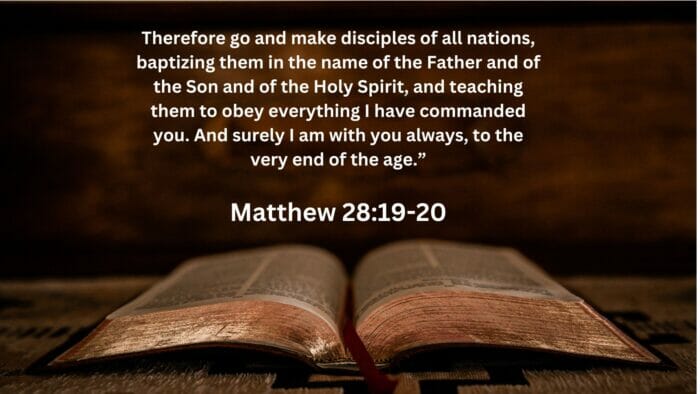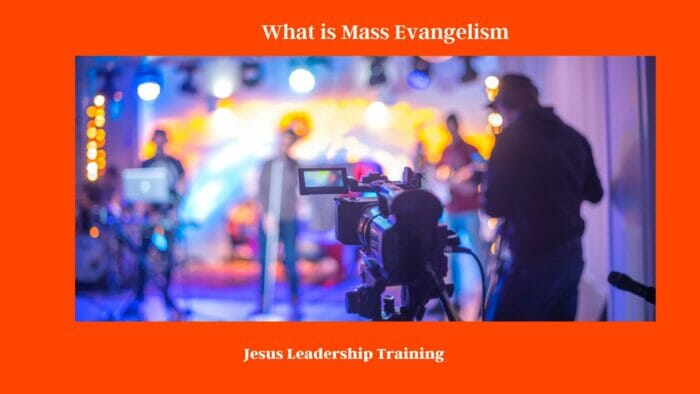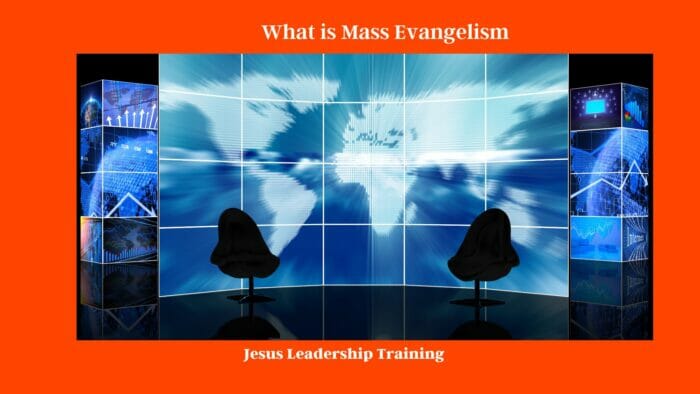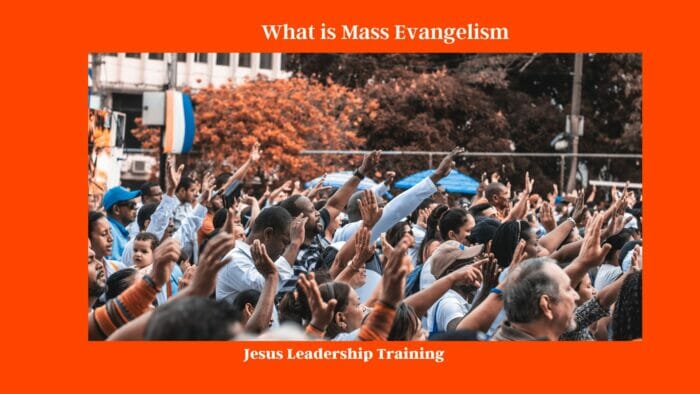Discover the comprehensive guide to understanding mass evangelism. Explore its meaning, impact, methods, and relevance in today’s world. Delve into the strategies, challenges, and FAQs associated with this powerful form of spreading a message.
Table of Contents
What is Mass Evangelism: Unveiling the Power of Mass Evangelism
What is Mass Evangelism – Mass evangelism is an influential approach to spreading a message, belief, or ideology to a large audience. This article serves as an extensive guide to help you understand the concept of mass evangelism, its significance, and the strategies employed to achieve its objectives.
We will explore the historical roots and the role of mass evangelism in various domains, including religion, marketing, and social movements. Get ready to dive deep into the world of mass evangelism and discover how it shapes our beliefs, perceptions, and actions.
1. Understanding Mass Evangelism (Personal)
Mass evangelism refers to the dissemination of a message or belief system to a vast audience simultaneously. This method aims to create a substantial impact and influence the thoughts and behaviors of a broad population. Whether it involves promoting religious faith, social causes, political ideologies, or commercial products, mass evangelism leverages effective communication channels to achieve its objectives.

2. The Historical Significance of Mass Evangelism
Throughout history, mass evangelism has played a pivotal role in shaping societies and cultures. From religious revivals and social movements to political campaigns and marketing endeavors, the power of reaching masses has been evident in transforming beliefs and rallying people behind a cause.
3. The Role of Mass Evangelism in Religion
In the realm of religion, mass evangelism has been a cornerstone of faith propagation. It involves evangelistic crusades, religious rallies, and outreach programs designed to draw people towards a particular religion’s teachings and principles. It has contributed to the growth and expansion of various religious movements worldwide.

5 Examples of Mass Evangelism in the Bible
| Event | Biblical Reference | Description |
|---|---|---|
| 1. Peter’s Sermon at Pentecost | Acts 2:14-41 | Following the descent of the Holy Spirit on the Day of Pentecost, Peter preached a sermon to a large crowd in Jerusalem. His message, which centered on the death and resurrection of Jesus Christ, led to about 3,000 people being added to their number that day. This is an example of mass evangelism where one message reached and converted a large number of people. |
| 2. Paul in Athens | Acts 17:16-34 | In Athens, Paul addressed a large crowd at the Areopagus, using the altar to an unknown God as his starting point to preach about the resurrection of Jesus. Although some mocked him, others became believers, demonstrating how mass evangelism can reach a diverse audience. |
| 3. The Feeding of the 5,000 | Matthew 14:13-21, Mark 6:31-44, Luke 9:12-17, John 6:1-14 | Though primarily a miracle story, the feeding of the 5,000 includes elements of mass evangelism. Jesus not only physically fed the crowd but also taught them, satisfying their spiritual hunger. |
| 4. Jesus’ Sermon on the Mount | Matthew 5-7 | Jesus delivered this sermon to a large crowd. The sermon contained many key teachings and principles of the Kingdom of Heaven, serving as a form of mass evangelism. |
| 5. John the Baptist’s Ministry | Matthew 3:1-12, Mark 1:1-8, Luke 3:1-18 | John the Baptist preached a message of repentance and baptism to large crowds in the wilderness, preparing the way for Jesus’ ministry. His bold, prophetic style of preaching attracted large audiences. |
4. Mass Evangelism in Marketing and Advertising
In the business world, mass evangelism finds its expression in marketing and advertising campaigns. Companies utilize various media platforms to reach a vast consumer base and promote their products or services. Understanding the principles of mass psychology and human behavior, marketers effectively use mass evangelism to create brand loyalty and drive sales.
| Church | Advertising Strategy | Description | Impact |
|---|---|---|---|
| 1. Life Church | Online Advertising | Life Church uses an extensive online advertising strategy, promoting their online sermons and ‘Church Online’ platform. They leverage search engine optimization (SEO) and social media ads to reach potential members. | This approach has helped them to establish a strong virtual presence and connect with individuals globally. |
| 2. Hillsong Church | Music and Events Promotion | Hillsong Church leverages its influential music ministry to attract mass audiences. They advertise concerts and events, which often serve as evangelical tools. | Their music has reached millions worldwide, drawing many to their church and spreading their teachings. |
| 3. Elevation Church | Television and YouTube Advertising | Elevation Church broadcasts its sermons on national television and YouTube. They use these platforms to advertise their upcoming sermons, events, and series. | These efforts have led to increased church attendance and widespread recognition. |
| 4. Lakewood Church | Book Promotions | Pastor Joel Osteen’s books are prominently advertised and widely read. These books serve as an evangelistic tool, sharing the church’s teachings with a large audience. | The wide readership of these books has drawn many people to explore the church further. |
| 5. Saddleback Church | Community Service Advertisements | Saddleback Church advertises its community service initiatives, inviting people to participate and experience their faith in action. | This has increased their community involvement and attracted individuals seeking a service-oriented faith community. |

5. Social Movements and Mass Evangelism
Mass evangelism has been a driving force behind social movements throughout history. From civil rights to environmental causes, passionate individuals and groups have used mass evangelism techniques to raise awareness, garner support, and drive positive change in society.
6. The Impact of Mass Evangelism on Public Opinion (Full)
The widespread dissemination of a message through mass evangelism can significantly influence public opinion. Whether it’s a political campaign or a social cause, reaching a vast audience can sway the collective mindset, leading to significant shifts in societal norms and values.
7. Strategies of Mass Evangelism
Mass evangelism employs various strategies to maximize its reach and impact. Understanding these tactics is crucial for effectively conveying a message to a large audience.
| Strategy | Description | Pros | Cons |
|---|---|---|---|
| 1. Online Evangelism | Using digital platforms to share the Gospel, including social media, websites, podcasts, and more. | Can reach a global audience, cost-effective, ability to engage with audiences in real-time. | Limited personal connection, can be less effective for those without digital access. |
| 2. Public Events | Organizing large-scale gatherings such as concerts, festivals, or speaking engagements. | Can attract large crowds, creates a communal experience. | Can be expensive, requires significant planning and resources. |
| 3. Media Broadcasting | Using television, radio, or newspapers to spread the message. | Wide reach, allows for creative presentations of the Gospel. | Can be costly, less interactive, subject to media regulations. |
| 4. Door-to-Door Evangelism | Visiting homes in a given area to share the Gospel personally. | Allows for personal engagement, can be tailored to individual’s needs. | Can be perceived as intrusive, time-intensive, limited reach. |
| 5. Literature Distribution | Distributing bibles, tracts, or other written materials with the Gospel message. | Easy to mass produce, can be shared and re-read. | Printing costs, may not be read or could be discarded. |
| 6. Street Preaching | Preaching the Gospel in public spaces. | Public visibility, potential to reach passersby. | May be ignored or met with hostility, limited control over environment. |
| 7. Community Service | Performing acts of service or kindness in the community as a way to share the Gospel. | Demonstrates Christian love in action, meets practical needs. | May not directly lead to Gospel conversations, requires resources and coordination. |

8. Utilizing Traditional Media Channels
Traditional media channels, such as television, radio, and newspapers, have long been vehicles for mass evangelism. Leveraging the wide viewership and readership, messages can reach diverse demographics.
What is Vision Casting – Proverbs 29:18 says, “Where there is no vision, the people perish
Check this vision – I would follow this – Greg Gaines
Churches are employing standard channels of media such as television and radio in their mass evangelism efforts in several innovative ways. These traditional mediums are powerful tools to reach a vast audience across various demographic and geographic boundaries. Here’s a detailed breakdown:
1. Television
- Regular Services: Many churches broadcast their regular services on television, allowing individuals who cannot attend in person to participate remotely. This can be especially beneficial for those with mobility issues, those living in remote areas, or those who simply don’t live near a church.
- Special Programs: Some churches produce special television programs that focus on particular aspects of faith. These could be Bible studies, interviews with church leaders, testimonials from congregation members, or explorations of Christian responses to contemporary issues.
- Advertising: Churches use television advertisements to share the Gospel message and to invite viewers to their services or special events. These advertisements often feature clips of worship, testimonials, and inspiring messages.
2. Radio
- Radio Shows: Many churches host regular radio shows, which can range from Bible teachings to discussions on Christian living. These shows are often interactive, allowing listeners to call in with questions or prayer requests.
- Sermons: Churches often broadcast their sermons over the radio. This allows those who couldn’t attend the service to hear the message.
- Music and Worship: Christian music can be a powerful evangelistic tool. Churches often partner with Christian radio stations to promote worship music, both from their own worship teams and from well-known Christian artists.
- Advertising: Like television, radio is also used to advertise church events and to share the Gospel. These advertisements can reach a broad audience, especially during peak listening times like morning and evening commutes.
These approaches allow churches to leverage the broad reach and accessibility of television and radio to share the Gospel message. However, it’s crucial that these initiatives are complemented by personal evangelism efforts to ensure that individuals have opportunities to respond to the Gospel message and become integrated into a faith community.
9. Embracing the Digital Era
In the digital age, mass evangelism has found new avenues through social media, websites, and online advertising. Digital platforms offer precise targeting and immediate feedback, enabling better engagement with the audience.
In the digital age, churches are strategically employing various digital media channels to further their mass evangelism efforts. The digital arena provides myriad opportunities to spread the Gospel message, and many churches are tapping into these resources to reach and engage with individuals around the world. Here’s an overview:
1. Websites
- Sermons and Teachings: Churches upload sermons and Bible studies to their websites, making them freely accessible to anyone with an internet connection.
- Online Services: Many churches live-stream their services or post recordings of their services online, which expands their reach beyond their physical walls.
2. Social Media
- Daily Devotionals and Inspirational Content: Churches use platforms like Facebook, Twitter, and Instagram to share daily devotionals, Bible verses, and inspirational messages.
- Event Promotion: Social media is a great way to promote church events, outreach programs, or special services.
- Community Engagement: Churches use social media to foster a sense of community among their members, encourage conversation, and provide a platform for members to share their faith.
3. Email Newsletters
- Regular Communication: Churches send regular email newsletters to their congregants to keep them informed about upcoming events, share devotionals, and encourage involvement in church activities.
4. Podcasts
- Sermons and Teachings: Many churches convert their sermons into podcast format, which allows individuals to listen at their convenience.
5. Mobile Apps
- On-Demand Content: Many churches develop mobile apps to offer on-demand access to sermons, Bible studies, church events, and more.
- Interactive Elements: Some apps offer interactive elements such as prayer requests, Bible reading plans, and opportunities for giving.
6. Online Giving Platforms
- Convenient Giving: Churches often offer online platforms that allow individuals to give tithes and offerings digitally.
7. Online Advertisements
- Outreach: Churches use digital advertisements to reach a wider audience, promote events, and share the Gospel message.
Through these digital channels, churches are able to carry out effective mass evangelism. Not only do these platforms help spread the Gospel to a wide audience, but they also offer a way for churches to connect with and nurture their congregation in new and interactive ways.
10. The Power of Storytelling
Storytelling is a potent tool in mass evangelism. By crafting compelling narratives that resonate with the audience, messengers can establish emotional connections, making the message more memorable and impactful.
11. Leveraging Influencers and Opinion Leaders
Collaborating with influencers and opinion leaders can significantly amplify the reach of a message. Their large followings and credibility can enhance the message’s legitimacy and encourage others to embrace it.
12. Creating Memorable Experiences
Mass evangelism often involves organizing large-scale events or experiences that leave a lasting impression on participants. These events create a sense of community and commitment to the cause.
13. Challenges and Criticisms of Mass Evangelism
Despite its widespread use, mass evangelism faces certain challenges and criticisms that need to be acknowledged and addressed.
Pros and Cons of Using Mass Evangelism to Preach the Gospel
| Mass Evangelism | Pros | Cons |
|---|---|---|
| 1. Broad Reach | Mass evangelism can reach a large number of people at once, spreading the gospel message to a wider audience. | It can be impersonal due to the scale, lacking the depth of connection possible in one-on-one evangelism. |
| 2. Economies of Scale | When resources (like time, finance, or personnel) are limited, mass evangelism can be more cost-effective per person reached. | The cost of organizing large-scale events or campaigns can be prohibitively high. |
| 3. Publicity | Mass evangelism events often garner attention from media, raising awareness of the church or organization among those who may not attend the event. | Negative public or media response to mass evangelism can harm the reputation of the church or organization. |
| 4. Inspiration | Large evangelistic events can be inspiring and energizing, helping to spark a renewed commitment to faith among attendees. | Some attendees may have an emotional response at the event but lack follow-up or discipleship, leading to shallow or temporary commitments. |
| 5. Unity | Mass evangelism can foster a sense of unity among different churches or Christian groups cooperating in the event. | Differences in doctrine or approach among cooperating groups can lead to conflict or confusion. |
| 6. Equipping Believers | Preparing for mass evangelism can equip believers with evangelistic skills and passion, benefiting local churches. | Mass evangelism can be seen as the work of specialists, discouraging personal evangelism by ordinary believers. |
14. Potential for Manipulation and Misinformation
The power of mass evangelism can be misused to manipulate public opinion or spread misinformation. It is essential to ensure ethical practices and fact-based messaging.
15. Balancing Passion with Rationality
In passionate pursuit of a cause, mass evangelism may sometimes neglect rationality and critical thinking. Striking a balance between emotions and reason is vital for responsible messaging.
16. Inclusivity and Diversity Concerns
Mass evangelism efforts should consider inclusivity and diversity to avoid marginalizing or excluding specific groups from the conversation.
17. Addressing Resistance and Skepticism
Mass evangelism may face resistance and skepticism, especially when challenging established beliefs. Understanding and addressing these concerns is crucial for successful outreach.
18. and Accountability
Evaluating the actual impact of mass evangelism initiatives can be challenging. Developing metrics for measurement and being accountable for results is essential for improvement.
When employing mass evangelism strategies, it’s crucial to establish clear, measurable objectives to evaluate effectiveness and adjust strategies as necessary. Here’s a list of some potential ways to measure the results of mass evangelism:
1. Attendance Numbers and Conversion Rates
- Church Services: Monitor the attendance numbers at regular church services. An increase may indicate effective outreach. Additionally, track the number of new converts during altar calls or other conversion opportunities.
- Special Events: Measure the attendance and conversion rates at special outreach events or evangelistic meetings. These can give a clear indication of the immediate impact of your mass evangelism efforts.
2. Baptisms and Membership
- Track the number of baptisms and new members joining the church. These can serve as key indicators of the effectiveness of your outreach efforts.
3. Digital Metrics
- Website Traffic: Use website analytics to track the number of visitors, page views, and the duration of visits. You can also track which pages or sermons are most popular.
- Social Media Engagement: Measure the number of likes, shares, comments, and follows on your social media platforms.
- Email Open and Click-Through Rates: Monitor the open rates of your email newsletters and the click-through rates on embedded links.
- App Downloads: If your church has a mobile app, monitor the number of downloads and active users.
4. Participation in Church Programs
- Track the number of participants in discipleship classes, Bible studies, or other church programs designed to deepen faith and foster community.
5. Surveys and Testimonies
- Conduct surveys or interviews to gather personal testimonies about the impact of your church’s evangelism efforts.
6. Community Impact
- Measure involvement in church-led community service projects.
- Track any increases in requests for assistance from your church’s community outreach programs, which could suggest greater awareness of your church in the community.
7. Financial Giving
- Monitor changes in tithes and offerings. Increases may suggest growth in the congregation or heightened commitment among existing members.
By tracking these measures, churches can gain a comprehensive picture of the success of their mass evangelism efforts. This information can be used to tweak strategies, allocate resources more effectively, and ultimately, better fulfill the church’s evangelistic mission.
FAQs About Mass Evangelism
Q: What Are Some Famous Historical Examples of Mass Evangelism? A: One of the most notable historical examples of mass evangelism is the Great Awakening in the 18th century, a religious revival movement in colonial America. Additionally, the mass evangelistic campaigns led by evangelists like Billy Graham in the 20th century have left a significant impact on Christianity worldwide.
Q: Can Mass Evangelism Be Used for Non-Religious Purposes? A: Absolutely! Mass evangelism techniques can be employed for various purposes, such as promoting social causes, political campaigns, or commercial products. The essence lies in effectively reaching a large audience with a specific message.
Q: How Has Digital Media Transformed Mass Evangelism? A: Digital media has revolutionized mass evangelism by providing new channels for communication and engagement. Social media platforms, in particular, have enabled real-time interactions with the audience, fostering a sense of community and virality.
Q: Does Mass Evangelism Only Involve Verbal Communication? A: No, mass evangelism encompasses various forms of communication, including visual storytelling, multimedia presentations, and experiential events. The goal is to create a comprehensive and impactful message delivery.
Q: Is Mass Evangelism Limited to Religious Movements? A: While mass evangelism has deep roots in religious contexts, its applications are not limited to religion. It has proven effective in various fields, such as marketing, politics, and social activism.
Q: How Can Mass Evangelism Drive Social Change? A: Mass evangelism can drive social change by raising awareness, inspiring collective action, and mobilizing a broad support base. It has played a significant role in advancing civil rights, environmental protection, and humanitarian causes. Christian Churches can use Sunday School to Harvest Souls. A Samaritan Christian, it is a Biblical Model for Christians. A gathering huge numbers of people into a single venue to hear the gospel may feel like the same as disciples’ first public ministry after jesus’ resurrection.
Conclusion: Harnessing the Power of Mass Evangelism
Mass evangelism remains a potent force for conveying messages and influencing public opinion across various domains. Whether utilized for religious purposes, marketing campaigns, or social movements, its ability to reach and impact a large audience is unparalleled. However, with this power comes the responsibility to use mass evangelism ethically and responsibly, ensuring that messages are factual, inclusive, and respectful of diverse perspectives.
As we move forward, understanding the strategies and challenges associated with mass evangelism can guide us in harnessing its power for positive change. When employed with integrity and a commitment to truth, mass evangelism can become a force for enlightenment, progress, and transformation.
As we navigate the digital age, the landscape of mass evangelism continues to evolve. With the proliferation of social media and instant communication, messengers can now connect with global audiences in real-time, sparking conversations and mobilizing communities like never before. This interconnectedness has unlocked new opportunities to champion causes, build networks, and foster meaningful relationships.
However, it is essential to recognize that not all messages conveyed through mass evangelism serve altruistic purposes. In some instances, this influential tool has been misused to propagate harmful ideologies, sow discord, and promote falsehoods. As stewards of mass evangelism, it is our collective responsibility to wield its power responsibly, using it to unite, educate, and uplift society.
In conclusion, mass evangelism is a multifaceted and impactful phenomenon that has shaped the course of history and continues to influence our world today. Its roots in religious revivalism have expanded to encompass marketing, politics, and social activism, exemplifying its versatility in shaping beliefs and driving change. Whether carried out through traditional media channels or the digital frontier, the potency of mass evangelism lies in its ability to reach a diverse audience and inspire collective action.
As we engage with mass evangelism, let us embrace its potential to spark positive transformations while remaining vigilant against potential pitfalls. By leveraging this powerful tool ethically and thoughtfully, we can contribute to a brighter, more informed, and compassionate world.
Remember, the true essence of mass evangelism lies not in merely propagating messages but in fostering understanding, empathy, and unity. Together, let us use this force for good and become catalysts for positive change on a global scale.
Best Bible Encyclopedias and Dictionaries
Below is a table featuring some highly regarded Bible Encyclopedias and Dictionaries along with their publishers and websites where they can be found or purchased.
| Title | Publisher | Website |
|---|---|---|
| The International Standard Bible Encyclopedia | Eerdmans | Eerdmans |
| Zondervan’s Pictorial Bible Dictionary | Zondervan | Zondervan |
| Easton’s Bible Dictionary | Thomas Nelson | Thomas Nelson |
| Holman Illustrated Bible Dictionary | B&H Publishing Group | B&H Publishing Group |
| The New Unger’s Bible Dictionary | Moody Publishers | Moody Publishers |
| HarperCollins Bible Dictionary | HarperOne | HarperOne |
| Vine’s Complete Expository Dictionary of Old and New Testament Words | Thomas Nelson | Thomas Nelson |
You can generally find these resources on the publishers’ websites, as well as other online book retailers such as Amazon or Christianbook. It’s always good practice to confirm availability and review additional details on the specific websites or other reliable online bookstores.





